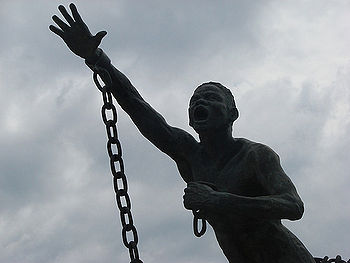- Benkos Bioho
-
Benkos Biohó (born late 15th century – 1621) was said to have been born in the region of Bioho, Guinea Bissau, West Africa where he was seized by the Portuguese Pedro Gomez Reynel, the dealer, sold to businessman Juan Palacios and resold as a slave to the Spaniard Alonso del Campo in 1596, in Cartagena de Indias. He established the maroon community of San Basilio de Palenque some time in the 16th century. He was betrayed and hanged by the governor of Cartagena in 1619.
The former African king escaped from the slave port of Cartagena with ten others and founded San Basilio de Palenque, the legendary "village of the Cimarróns". In 1713 it became "the first free village in the Americas" when the King of Spain gave up sending his troops on futile missions to attack their fortified mountain hideaway.
He is the great-great-great-great-grandfather of the late Afro-Colombian singer, composer and drummer, Paulino Salgado Valdez (Batata).
Also known as Domingo Bioho, he used a boat to travel down the Magdalena River to escape to freedom. He was recaptured, but escaped again in 1599 into the marshy land southeast of Cartagena. He organized an army that came to dominate all of the Montes de Maria. He also formed an intelligence network that collected and used information that would lead to the collapse of the city. He organized more escapes of runaway slaves to liberated territory, known as settlement. He was named king of handguns. Benko's name corresponds to a place east of the Senegal River.
Unable to defeat the Maroons, on July 18, 1605, the Governor of Cartagena, Gerónimo de Suazo y Casasola, offered a peace treaty to Benkos Bioho, recognizing the autonomy of the Palenque Matuna Bioho accepting that entered the city armed and dressed in Spanish, while the arena promised not receive more feral or stimulate new leak or to use title of king. Peace will only be finalized in 1612 under the governorship of Diego Fernandez de Velasco. The treaty was violated by the Spanish in 1619 when walking carelessly Bioho was caught by the guard of the wall and caught: he was hanged and quartered on 16 March 1621. Governor Garcia Giron who ordered the execution, arguing that it was dangerous bitterly respect Bioho generated in the population and that "lies and enchantment behind it takes all the nations of Guinea is in the city."
By the end of the seventeenth century in the area of Montes de Maria had over 600 Maroons, under the command of Domingo Padilla, who claimed for himself the title of captain while his wife Jane adopted that of viceroy, and successfully challenged attempts at sovereignty of the colonial authorities.
Historian Maria del Carmen Borrego Pla, using two subsets of the Archive of the Indies in Spain published a study on runaway blacks in Cartagena in the late seventeenth century, bordered on three geographic areas as well: the north in the Sierra Luruaco composed of black Creoles and known by the names of Betancur and Matubere; the center in the Montes de Maria, with people longstanding Maroon, arranged in four runaway, but only mentioned two of them, San Miguel and the Arenal, the south in the mountains of San Lucas, between the rivers Magdalena and Nechi, known as the palisades of Norosi and Cimarron, formed by black Creoles.
He later called Palenque de San Basilio was a symbol of independence for runaway slaves, became the first Free People of America, by Royal decree of the King of Spain in the year 1713. There he speaks its own language so far from the Old Portuguese, including words from African languages. Africans captured and spoke in different languages in the boat dealers, to communicate, learn the Portuguese language of their captors. When escape had not yet learned the Castilian and came to the fence to talk in Portuguese.
San Basilio de Palenque was declared "Masterpiece of Oral and Intangible Heritage of Humanity" by UNESCO in 2005.[1] At about 50 miles east of Cartagena, on hills of strategic value were used as lookout posts, still hear the names of the runaway Neighborhood: Sincerin, Mahates, Gambot.
References
External links
- Africans in Americas
- Central Africans and Cultural Transformations in the American Diaspora By Linda Marinda Heywood ISBN 0521002788
- Africa and the Americas: Interconnections During the Slave Trade By José C. Curto, Renée Soulodre-LaFrance Published 2005 Africa World Press Slave trade ISBN 1592212727
- Africana: The Encyclopedia of the African and African American Experience By Henry Louis Gates, Anthony Appiah ISBN 0465000711
- Facebook|Paulino Salgado Valdez (Batata)
Categories:- African diaspora
- Maroons
- History of Colombia
- Rebel slaves
- Slave rebellions
- Colombian people of Black African descent
- 15th-century births
- Year of birth uncertain
- 1621 deaths
Wikimedia Foundation. 2010.

